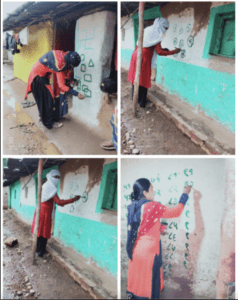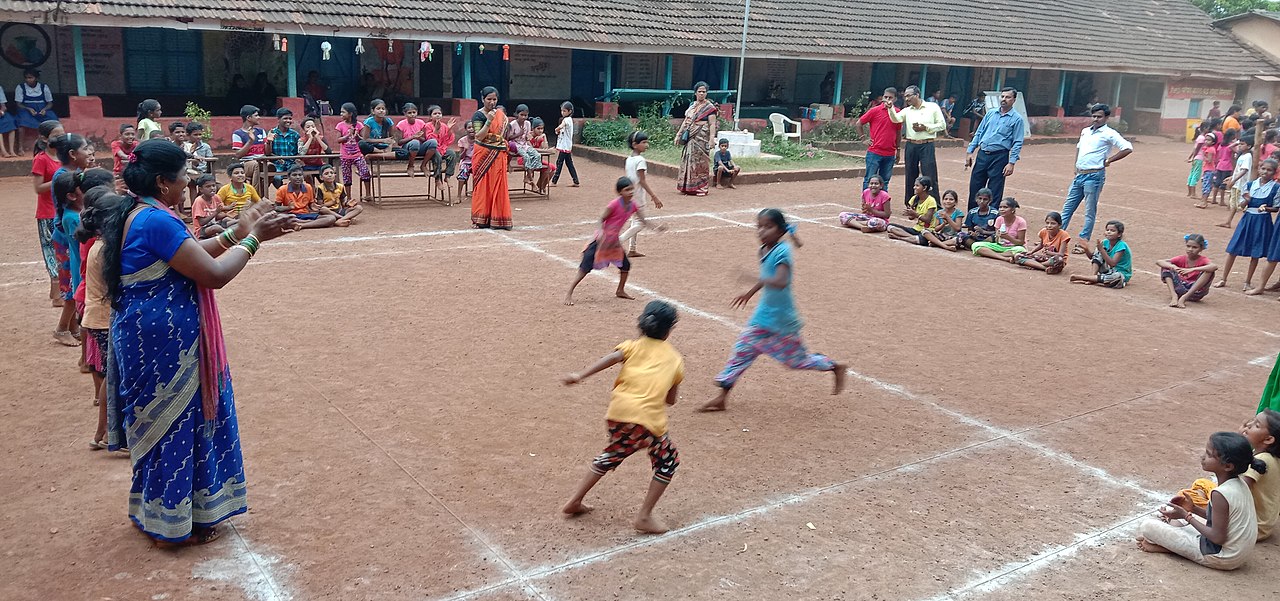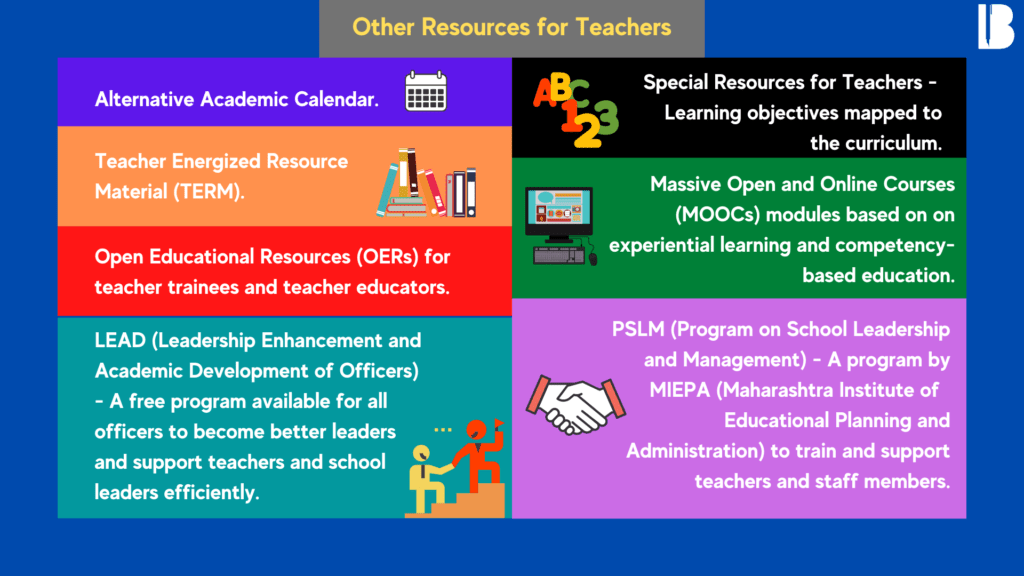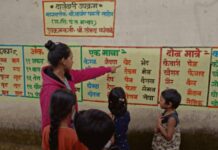The COVID-19 pandemic has shone a harsh light on the vulnerabilities and challenges faced by students across the world. Students, teachers, and parents have all faced the consequences of a digital divide and school closures, affecting their abilities to learn, teach, and communicate. Yet, the prolonged closure of schools and colleges has highlighted the underlying concerns of the public education system—which existed much before COVID-19 ever hit India.
Considering the pandemic has wiped out several decades of progress in education—most notably in terms of poverty alleviation and gender equality—a drastic shift in teaching-learning plans is required to adapt to the current status quo. The shortcomings of the state of online at-home learning can give us a clearer picture of the steps ahead as we design solutions for the “new normal”. These solutions, to be used by all stakeholders in the education system, need to be implementable, easy, and collective in nature. More importantly, given the current scenario, it is crucial to integrate health into the fold of education. Here are nine policy recommendations, complemented by pioneering examples of on-ground implementation from Maharashtra, on how this can be done.
Recommendation 1: Focus On Hygiene
UNICEF’s “Education in a Post-COVID World” report brings to our notice how “public health and public education are closely interconnected as they show the undeniable necessity of collaboration, solidarity, and collective action for the common good (..) The global health pandemic will not be defeated by health measures alone. It will be solved by building civic trust, deepening human empathy, progressing in science, and appreciating our common humanity.”
Clearly, additional measures will have to be put in place to ensure students, teachers, and parents are safe and healthy while at school. Enforcing these will only bolster the confidence of community members to send their children back to school at all. Ensuring functional and hygienic facilities at schools will be a crucial part of their reopening safely. Administrators should improve and implement protocols for handwashing, respiratory etiquette (that is, coughing and sneezing into one’s elbow), physical distancing measures, cleaning, and food preparation. The school’s administrative staff and teachers should be trained in these practices to easily implement them.
Putting this to practice, teachers in Sangli district have gone out of their way to procure hand sanitisers, masks, soap, and sanitary napkins from various NGOs and community members for children in their surrounding communities. “Education and health go hand in hand,” says Sudha R. Patil, an English Vishay Sahayak with Sangali DIET.”If either the children or parents are not educated about hygiene, their health will deteriorate and they won’t be able to focus on their education. It is our job as teachers to educate them, and at the same time, initiate the habit of using these products by first procuring them and then helping them procure them for themselves. This process of gradual development of responsibility for their health and hygiene will go a long way.” As the school have been closed for months it is also important to make sure the washrooms and classrooms are clean and hygienic for both girls and boys.
Another example is a joint monitoring program for WASH (Water, Sanitation, and Hygiene) run by UNICEF, the World Health Organization (WHO), State Council of Education Research and Training Maharashtra (SCERT), and Centre for Youth Development and Activities (CYDA). Under it, 360 nodal teachers across Maharashtra have been appointed to support teaching and non-teaching staff to follow COVID-19 protocols.
Recommendation 2: Bring Out-of-School Children Back to School
“A few of my student’s parents moved to Gujarat for work,” recalls a teacher from Dhule district. “With this transition, students have been out of school and out of touch with me. When I received news that they were staying in temporary houses along the border of Maharashtra, (around 75 kilometres away from the school) I travelled there along with a few community members to get in touch with the parents and students and help them understand the gravity of their education losses. Sometimes, these extra efforts have to be made to retain students.”
Efforts are constantly being made by teachers and community members to retain students, however, given the socio-economic shocks of the pandemic, successfully doing so like the teacher from Dhule did, is not always possible. Out-of-School Children (OOSC) require appropriate support to bring them back into the fold of the education system. The roles of parents, community members, and local bodies have become all the more important in this exercise: their involvement is the key to mitigating learning losses for these children.
In Maharashtra, the state government’s Balrakshak initiative, active since January of 2017, has played a huge role in bringing students back to school. Two Balrakshaks are appointed at each block, five at every urban resource centre, and two at every tribal cluster—which adds up to a total of 2,792 balrakshaks currently on the field helping out of school children.
The Ministry of Education also offers a three-pronged strategy to bring students back to school. The first step of this is the Maintain Phase, where teachers maintain education services through initiatives such as home learning, developing student registries to identify and bring OOSC back to school, and continuous engagement with parents and community members. Then comes the Restore Phase when schools reopen, where the focus is on learning recovery. Here, it is crucial to identify students who are unable to physically come back to school and restore their access to education through various online learning platforms. Finally, in the Grow Phase, teachers should closely track the learning levels and outcomes of students in both online and offline modes of learning. In this phase, teachers will leverage all available resources to ensure the continuity of quality and equitable education.
Recommendation 3: Address Child Marriage
The risk of child marriage increases with rising economic shocks and prolonged school closures: many Indian parents, in order to relieve the family’s financial pressures, marry their daughters. Shireen Jejeebhoy notes that of calls made during the first lockdown to Childline, a government hotline for children in distress, “5,584 distress calls were to address child marriage, representing a 33% increase in reports of child marriage to ChildLine between Jan-June [sic] 2019 and Jan-June [sic] 2020.”
“It was very difficult to see young girls wearing mangalsutras [an auspicious thread worn by a married woman], instead of carrying school bags,” narrate Kunda Bachav, Vaishali Bhambre, and Prashant Patil, all teachers at Anandwali, a Nashik Municipal Corporation school. “We are in the 21st century yet, talented, smart girls have to face this because of their family’s financial conditions.”
There are still actions that can be taken by teachers and community members to prevent such marriages from happening. These include safeguarding every child’s access to education, enacting comprehensive social protection measures, raising awareness on child marriage and the consequences of early pregnancies, and procuring funds to enable girls to finish school. Bachav, Bhambre, and Patil did just this in Nashik.
“Once we realized that the core reason behind four of our girls being married off was the pandemic-induced economic shock faced by their families, we decided to channelize all our energy into funding their education,” they recall. Bachav adds, “we pooled money from our own pockets, from donation drives, and from local, political, and corporate authorities to make sure no girl had to face these challenges. I myself am funding the education of five girls from my school.” This small initiative was supported by the District Education Officer, Divisional Commissioner, Charity Commissioner, and local NGOs. Collectively, they were able to fund the education of 60 girls until graduation.
Along with providing the funds, teachers at Anandwali organized counselling sessions for the parents, both collectively and individually. They discussed the consequences of early marriages and early pregnancies, as well as how educating their daughters would positively impact the family’s economic conditions. The school also arranged an awareness campaign on the consequences of child marriage and child labour, where anyone from the parent community could come to school and talk about these issues or seek advice on them.
Recommendation 4: Leverage Socio-Emotional Learning
Moving forward, it is important to consider the mental and emotional challenges students have faced during the pandemic. Be it losing their loved ones, migrating from one city to the other, or the loss of social interaction they’ve faced while at home, all these factors come together to affect their academic goals and personal development. These goals cannot be fulfilled without social-emotional knowledge and skills that develop self-awareness, self-management, social awareness, relationship skills, and responsible decision-making. Socio-Emotional Learning (SEL) could help transform this state of affairs.
The Collaborative for Academic, Social, and Emotional Learning (CASEL) defines SEL as “how children and adults learn to understand and manage emotions, set goals, show empathy for others, establish positive relationships, and make responsible decisions.” Returning to face-to-face learning requires that SEL goes beyond the basics of simply making students aware of their emotions, and extends to helping them process their return to an educational institution. For example, reading and exercise should be promoted among children to develop their creative and physical strengths, while parents should be made aware of the psychological needs of their children, as well as the need to be more communicative with them. To that end, the help of counsellors or community members should be taken into consideration to raise awareness of sensitive or heightened emotions among parents and students. This can be achieved through peer-to-peer sessions so that students can express their feelings freely and build a support system within their own circles.
In terms of how this operates in the classroom: teachers working in Pimpri Chinchwad Municipal Corporation schools are encouraging students and parents to identify their “feeling of the day”. The teachers share four emotions per day and ask students to label four cups with them. Throughout the day students are expected to keep a check on which emotions they’re feeling and add either rice or small pebbles to the feelings cup.
Such activities enable both students and parents an opportunity to identify their own emotions and those of the people around them. “I never intentionally paid attention to my feelings before,” says Garima*, a student from a PCMC school. “This makes it easier for me to know how I feel during a certain activity. It also helps me understand my siblings and my parents better. Knowing how someone feels, makes it easier to communicate with them.” These activities have helped students and parents perceive mental health from a new lens and make efforts to empathize with each other.
Recommendation 5: Develop Bridge Courses
“The lockdown has been hard on all of us, but the students have faced a lot of difficulties with respect to their studies,” says Archana Meshram, a teacher at a Zilla Parishad School in Dharni, Amravati district. “Some of them want to study but can’t as they don’t have devices, or don’t know how to operate them, or are unable to recharge their phones due to financial constraints. This just increases their learning gap.” The Annual Status of Education Report (ASER) 2020 corroborates this, noting a learning loss of 1.5 years for Indian children as a result of the pandemic.
As students and teachers prepare for the upcoming academic year to be offline, having a set plan in place to bridge learning gaps brought about by the pandemic is key. This will only make it easier for the students to learn, understand, and apply topics in their new grades. To address this, the Maharashtra SCERT has developed bridge courses to minimize the learning losses for students of grades 2 to 8. Spread across 45 days with an assessment every 15 days, this course helps teachers identify which students need support with the previous grade’s content and the type of support needed. Utilizing them will enhance the foundational numeracy and literacy of each child, as well as their revision and retention abilities.

On her own steam, Mesharam has taken extra effort to bridge this gap too, using the support of the communities surrounding her. Teachers at her school first identified the basic concepts students need to practice. “Then, to make sure students don’t forget these concepts, a few of us decided to leverage the community and paint the walls with them,” Mesharam explains. “This is something that will help the children through their offline and online schooling journeys. The paintings have also encouraged parents and other community members to learn the concepts themselves and encourage students to do the same. Some of the walls included small activities that students can perform, painted by the community members themselves. Seeing them take such ownership to bridge the gap is what makes me love my job.”
Recommendation 6: Strengthen School Management Committees and School Management Development Committees
Fostering the kind of community participation seen above is one of the most important elements of reopening schools. Leveraging various stakeholders to help students and children seamlessly transition from online to offline platforms will help bridge learning gaps and support teachers.
This can be enabled using the two robust committees public schools have in place: the School Management Committee (SMC) and School Management Development Committee (SMDC). These committees have enabled parents to be engaged in the development of the school, and in the provision of support or resources for students. Ramdas Patil, a teacher from Zilla Parishad School Mahalwadi, in Pune explains why SMCs and SMDCs are relevant in the pandemic. “A strong partnership between teachers and parents will ensure that learning goals are met and that both the teachers and the parents are held equally accountable for the student’s learning.”
Motivated members of the committee, which could include alumni, parents, and retired teachers, can provide a socio-emotional support base for children while reducing the burdens teachers bear. This role becomes more important given that some parents are unable to support children in academic activities. “The SMC of our school is very strong, we have collectively transformed our village into an Abhyasache Gaon [a village of education],” says Patil, describing how the SMC transformed the school during the pandemic. “We have cleaned and painted common areas for children to sit and learn in, and have also set up speakers and radios in these spaces. None of this would have been possible just because of the teachers. Parents and college students volunteered to help and support them. Together, we created a robust plan to conduct assessments, provide xerox copies of worksheets and important content, conduct group activities and procure funds to paint the walls and provide students with either devices or stationary. It’s all a collective effort that makes our school and our community do so well.”

Another example is of how Hemant Sapkale, a teacher at the Zilla Parishad School, in Chinchkhede, Jalgaon district, along with the school’s community created a “Shikshan Rath” (or education chariot. The car, equipped with learning materials, patrolled the surrounding neighbourhood and helped students continue their education.
Recommendation 7: Foster Peer Learning and Experiential Learning
Peer learning encompasses a broad list of activities, with its student benefits as diverse too. Techniques range from the traditional proctor model—where senior students tutor junior students—to the more innovative style where students from the same grade assist each other with both course content and personal concerns. Peer learning involves discussion seminars, private study groups, buddy systems, counselling, and peer-assessment schemes, and encouraging students to adopt this online has been challenging for teachers. The lack of such sessions could impact student learning: especially given that peer learning improves students’ attitudes towards learning, fosters a personalized learning experience, and leads to higher academic achievement.

With the possibility of offline classes taking place in the future, the core focus of the teachers should be to once again engage in peer learning. This will enhance their collaborative learning, make way for innovation, and develop interpersonal communication skills. This is what Devidas Gunjkar, a teacher from Zilla Parishad School in Puyana, Hingoli district has done for her class for the past year, by carefully balancing the offline and online. “The school has been shut since March 2020, however for us teachers, it hasn’t,” she says. “We have made sure that through peer learning, students are able to learn new concepts and focus on their socio-emotional learning as well. The surrounding communities are divided into about four to five smaller areas. I have formed small groups for each of them. Students gather either in a common space or on someone’s porch, and while following social distancing norms, learn and teach each other. Every day I visit all these groups, guide them and help them with the challenges they face. It’s lovely to see children take ownership of their own studies and hold each other accountable too. I have taught concepts to the entire class online too, but practising together is the real key to their success.” The Maharashtra SCERT has also launched a “Learn with Fun” initiative, that encourages students to indulge in small and simple activities through art, craft, dance, yoga, and drama every Saturday.
Recommendation 8: Build the Capacities of Teachers and the Resources They Have Access To
Both virtual and hybrid learning models must be implemented with sensitivity and care, lest they exacerbate prevailing social inequalities, biases, and privileges. The seed of an effective blended teaching-learning model is efficient and well-trained teachers.
It becomes crucial then to prioritize teacher capacity building. Over the past year, programs like the National Initiative for School Heads and Teachers Holistic Advancement (NISHTHA) and District Institute for Education and Training (DIET) created easily implementable self-learning programs for teachers to learn and teach concepts easily through online platforms. Capacity building at the community level is also key: where teachers from nearby communities gather in a peer learning circle to support each other during the transition from online to offline transition.
Shikshak Mitra is one such initiative by the Maharashtra SCERT where one teacher is responsible for a group of teachers learning new concepts. Dattatraya Yadav, a teacher from the Zilla Parishad School in Harangul, Latur district, has supported more than 1,500 teachers—both before and during the pandemic—with respect to using technology. “Peer learning is one of the best ways to learn a new concept, be it for adults or for children,” says Yadav. “Being a Shikshak Mitra helped me train teachers from various schools, and at the same time, learn from them as well. All the teachers have new ideas or techniques that can be used in the classroom. Now that everything’s online, we share our best practices and successes on WhatsApp.”
Recommendation 9: Continue Using Technology
One key takeaway from the pandemic is that conventional classroom teaching is still the best mode of learning. However, technology enables learning in its own way, and should feature in new learning models.
For example, over the past year, many states have effectively and efficiently used DIKSHA, the Centre’s digital information-sharing platform, to share curricular content and easy teaching techniques. Various states have also developed state-specific websites and mobile applications which aim to enable all stakeholders to access content based on their weekly schedules. The radio has also played a major role in extending education coverage across India. The government-owned All India Radio (AIR) made it possible for students in rural and tribal areas to access learning and socio-emotional content, and co-curricular activities that students could try at home. In a few districts in Maharashtra, loudspeakers placed in public spaces were used to narrate stories, rhymes, tables, exercise routines, and simple instructions for arts and craft activities.

With schools now slowly moving back to the offline stage, and given that students are entering a tech-driven job market, it is important to still connect to students using technology as diversely as before. As Sujata Borase, a teacher from a Zilla Parishad School in Wadewarhi, Nashik district shares “I was using tablets in my class before the pandemic hit. This made it really easy for me to take online classes and help students with their challenges. Because I was aware of the kind of challenges they could or would face, I was able to instruct them well and use PowerPoint presentations, Zoom, and simple online games very easily while teaching. Be it, offline or online classes, technology is the future, and we must use it to empower our students”
The Road Ahead
Amidst the pandemic’s extraordinary circumstances, teachers from across Maharashtra have taken tremendous efforts to safeguard the Right To Education Act and to facilitate learning for as many students as possible.
Yet, in spite of this effort, our society is still plagued by a very evident digital divide, a by-product of the divide between the haves and the have-nots, the urban and rural, and various upper and lower castes and classes. To bring equality and equity into the classrooms, we must first work on bridging this gap.
*Names changed. | Featured image: girls playing langdi at a government school sports meet in Maharashtra, by V.K. Suradkar (CC BY-SA 4.0).







